The Lead-to-Account Matching and Routing Software Market is estimated to be valued at USD 2.6 billion in 2025 and is projected to reach USD 6.6 billion by 2035, registering a compound annual growth rate (CAGR) of 9.6% over the forecast period.
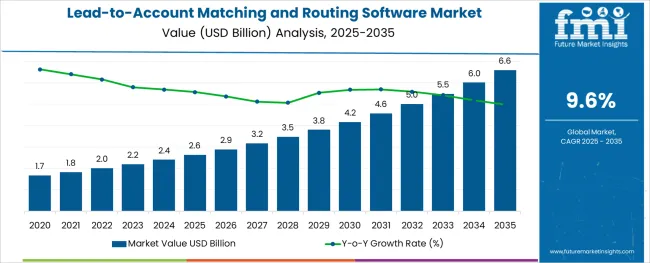
The lead-to-account matching and routing software market is experiencing steady momentum, driven by the increasing demand for precision-based sales and marketing alignment tools that improve customer acquisition efficiency. As businesses intensify efforts to streamline lead management, ensure prompt routing of qualified prospects, and minimize operational delays in sales processes, reliance on automated software platforms has surged.
The market has benefitted from growing investments in customer relationship management (CRM) ecosystems and digital transformation initiatives, particularly within technology, financial services, and healthcare industries. Future growth prospects appear favorable, supported by the integration of AI-powered functionalities such as intelligent scoring, predictive routing, and real-time data enrichment.
Additionally, the rise of remote and hybrid work models has heightened the need for seamless, cloud-enabled solutions capable of operating across distributed sales teams and decentralized operations. These factors, coupled with the increasing importance of data governance and compliance in handling lead data, position the market for sustained double-digit growth over the next several years, especially as organizations prioritize scalable, efficient, and accurate lead management capabilities.
The market is segmented by Type and Application and region. By Type, the market is divided into Cloud-based and On-premises. In terms of Application, the market is classified into Large Enterprises and SMEs. Regionally, the market is classified into North America, Latin America, Western Europe, Eastern Europe, Balkan & Baltic Countries, Russia & Belarus, Central Asia, East Asia, South Asia & Pacific, and the Middle East & Africa.
The market is segmented by Type and Application and region. By Type, the market is divided into Cloud-based and On-premises. In terms of Application, the market is classified into Large Enterprises and SMEs. Regionally, the market is classified into North America, Latin America, Western Europe, Eastern Europe, Balkan & Baltic Countries, Russia & Belarus, Central Asia, East Asia, South Asia & Pacific, and the Middle East & Africa.
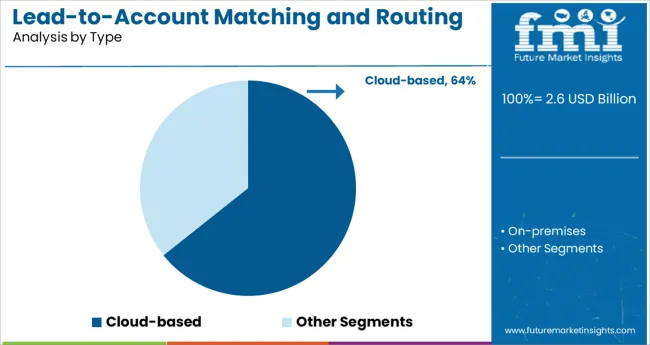
The cloud-based segment accounted for approximately 64.3% of the total lead-to-account matching and routing software market share, establishing itself as the dominant deployment type. This segment’s leadership is underpinned by rising enterprise preferences for flexible, scalable, and maintenance-free solutions that can be deployed rapidly and accessed remotely.
As businesses seek to optimize operational costs and reduce IT infrastructure dependencies, cloud-based platforms have become increasingly integral to modern lead management strategies. The segment has also gained traction due to its compatibility with widely adopted CRM systems and sales engagement tools, facilitating seamless integration and data synchronization.
Moreover, the ability to implement real-time updates, security enhancements, and AI-powered features without extensive on-premise configurations has contributed to its widespread acceptance. The growing prevalence of remote selling environments and virtual account-based marketing operations further reinforces demand for cloud-based platforms. In the near term, it is anticipated that vendors will continue enhancing cloud-native capabilities, incorporating advanced analytics and AI-driven routing engines to maintain the segment’s growth momentum.
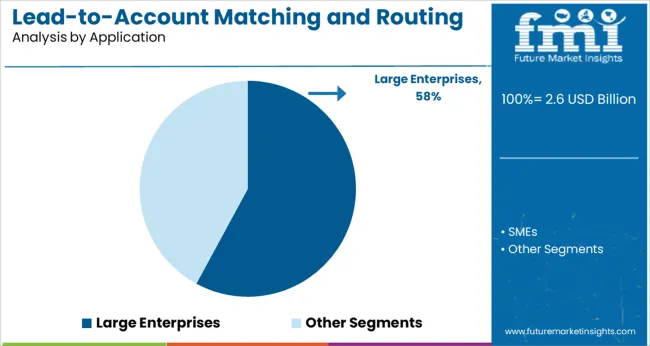
Within the application category, the large enterprises segment held a substantial 57.9% market share, reaffirming its position as the primary revenue contributor in the lead-to-account matching and routing software market. This dominance is attributed to the extensive lead volumes, complex sales cycles, and multi-tiered organizational structures typically present in large enterprises, necessitating highly automated, accurate, and scalable lead routing solutions.
Large organizations often operate across diverse geographical markets and product verticals, increasing the complexity of lead-to-account alignment and necessitating robust software capable of integrating with multiple CRM systems and data sources. The segment's growth has been further reinforced by the heightened emphasis on improving conversion rates, accelerating pipeline development, and ensuring compliance with stringent data privacy regulations.
Additionally, large enterprises have demonstrated a willingness to invest in advanced software suites that offer AI-driven insights, dynamic lead scoring, and predictive routing functionalities. Looking ahead, continued digital transformation initiatives and rising demand for unified, enterprise-grade lead management platforms are expected to sustain this segment’s commanding market position.
Attracting potential consumers over digital platforms has turned out to be the most critical factor for the success of any enterprise in this age of information. The application of suitable software to carry out this requirement with enhanced user experience has set in the demand for lead-to-account matching and routing software market.
The software analyzed for the lead-to-account matching and routing software market report not only saves time and resources by automating GTM operations but also assists in sending cleaner and more accurate data into the company’s CRM. The software tools that can detect the occurrence of any repetitive data and reduce duplication are expected to further augment the lead-to-account matching and routing software market future trends in the coming days.
The function of revenue operations can benefit from the automatic routing solutions that can minimize the loss of new leads and establish account routing rules that are predicted to influence the lead-to-account matching and routing software market key trends and opportunities in the future.
Integration of a number of other key variables, such as information on account history or even lead source, is considered to play a greater role in the adoption of lead-to-account matching and routing software by the end users.
The ongoing tussle between public administration and big corporate houses, in the domain of digital data management software, regarding the privacy and security of data is expected to restrain the emerging trend in the lead-to-account matching and routing software market to a certain extent.
Also, the higher cost associated with the installation and maintenance of the digital system is a major limiting factor for the growth of lead-to-account matching and routing software market size in different verticals.
The market for lead-to-account matching and routing software is divided into three categories: Type, Application, and region. The market is divided into two types of deployments: cloud and on-premise. The lead-to-account matching and routing software market are further divided into SMEs and large enterprises, depending on company size. In terms of revenue and projection for the period 2025 to 2035, the segmental analysis focuses on revenue and forecast by type and Application.
The global lead-to-account matching and routing software market has been segmented into two groups based on comprehensive research: On-premise and cloud-based. On-premise in the global lead-to-account matching and routing software market category by type has a considerable market share. Cloud-based is the leading market by type, with a forecasted CAGR of 9.3% during the projected period.
According to FMI, the global lead-to-account matching and routing software market is divided into two categories based on Application: large enterprises and SMEs. Large organizations dominate the global lead-to-account matching and routing software market, which is predicted to grow at a 9.4% CAGR through 2035.
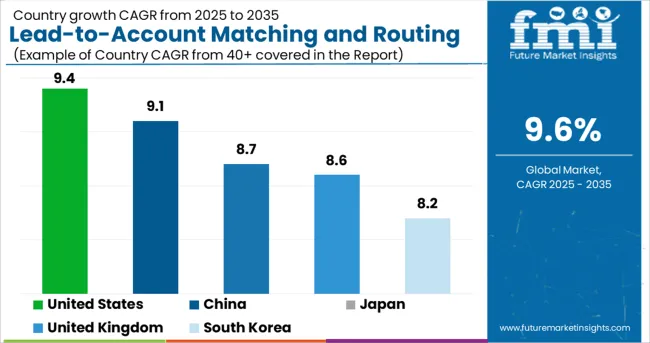
| Regions | CAGR (2025 to 2035) |
|---|---|
| United States | 9.4% |
| United Kingdom | 8.6% |
| China | 9.1% |
| Japan | 8.7% |
| South Korea | 8.2% |
Among the other regions, the USA is anticipated to dominate the lead-to-account matching and routing software market during the forecast period. An increasing number of digital businesses in North America is likely to generate demand for digital marketing-related solutions.
Since lead-to-account matching and routing software is an advanced routing and scheduling solution for B2B teams looking into the revenue aspect, the adoption has grown for achieving high inbound conversion rates, new levels of productivity, and customer satisfaction. In the coming years, as businesses march towards digitalization, North America is likely to stay dominant in terms of adoption as well as the development of such solutions.
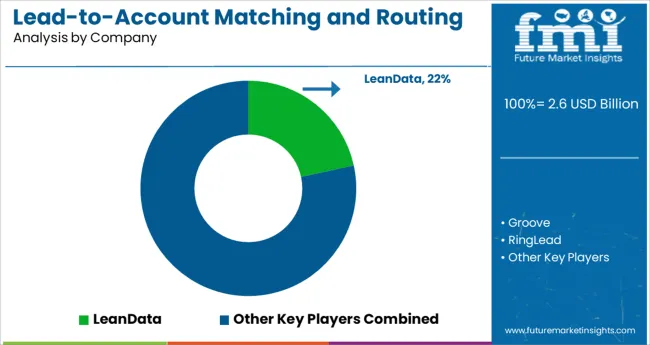
Lead-to-account matching and routing software market compete mostly on the basis of providing innovative and efficient services. The statistics show how competitors are capitalizing on the market for lead-to-account matching and routing software.
With the increased demand for Lead-to-account matching and routing software in the global market, market players in the Lead-to-account matching and routing software market are expected to benefit from attractive growth prospects in the future.
The global lead-to-account matching and routing software market is estimated to be valued at USD 2.6 billion in 2025.
It is projected to reach USD 6.6 billion by 2035.
The market is expected to grow at a 9.6% CAGR between 2025 and 2035.
The key product types are cloud-based and on-premises.
large enterprises segment is expected to dominate with a 57.9% industry share in 2025.






Full Research Suite comprises of:
Market outlook & trends analysis
Interviews & case studies
Strategic recommendations
Vendor profiles & capabilities analysis
5-year forecasts
8 regions and 60+ country-level data splits
Market segment data splits
12 months of continuous data updates
DELIVERED AS:
PDF EXCEL ONLINE
Digital Freight Matching Market Size and Share Forecast Outlook 2025 to 2035
Software-Defined Wide Area Network Market Size and Share Forecast Outlook 2025 to 2035
Software Defined Vehicle Market Size and Share Forecast Outlook 2025 to 2035
Software Defined Perimeter (SDP) Market Size and Share Forecast Outlook 2025 to 2035
Software-Defined Wide Area Network SD-WAN Market Size and Share Forecast Outlook 2025 to 2035
Software Defined Radio (SDR) Market Size and Share Forecast Outlook 2025 to 2035
Software License Management (SLM) Market Size and Share Forecast Outlook 2025 to 2035
Software-Defined Networking SDN Market Size and Share Forecast Outlook 2025 to 2035
Software-Defined Anything (SDx) Market Size and Share Forecast Outlook 2025 to 2035
Software-Defined Data Center Market Size and Share Forecast Outlook 2025 to 2035
Software Containers Market Size and Share Forecast Outlook 2025 to 2035
Software Defined Networking Market Size and Share Forecast Outlook 2025 to 2035
Software-Defined Camera (SDC) Market Size and Share Forecast Outlook 2025 to 2035
Examining Market Share Trends in the Software Distribution Industry
Software Distribution Market Analysis by Deployment Type, by Organization Size and by Industry Vertical Through 2035
Software Defined Video Networking Market
UK Software Distribution Market Analysis – Size & Industry Trends 2025-2035
RIP Software Market Size and Share Forecast Outlook 2025 to 2035
VPN Software Market Size and Share Forecast Outlook 2025 to 2035
3PL Software Market Size and Share Forecast Outlook 2025 to 2035

Thank you!
You will receive an email from our Business Development Manager. Please be sure to check your SPAM/JUNK folder too.
Chat With
MaRIA